|
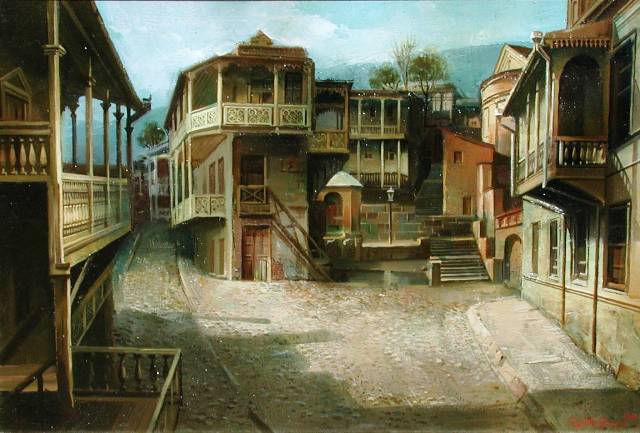
AN AMERICAN SUPRA
or
Drown,
Swim or Fly
A Fulbright Scholar’s
Journal: Georgia, 2001-2002
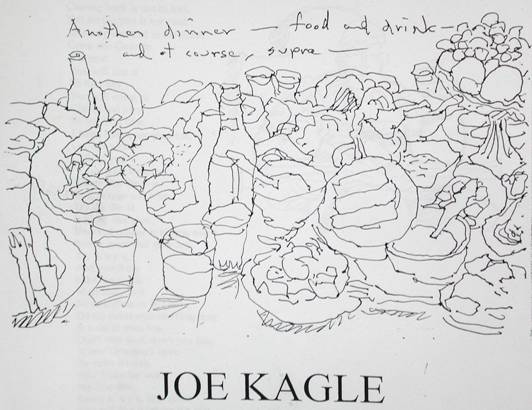
Preparing To Be A
Fulbright Scholar
or
Luck Comes To Those
Prepared
Mirrors should reflect a
little before throwing back images.
Jean Cocteau, 1891-1963,
from Des Beaux-Arts
The most outstanding
characteristic of Eastern civilization is to know
contentment, whereas that of Western civilization is not to
know contentment. Contented Easterners are satisfied with
their simple life and therefore do not seek to increase
their material enjoyment…They are satisfied with their
present lot and environment and therefore do not want to
conquer nature but merely be at home with nature and at
peace with their lot. Hu Shih, 1891-1962
We must conquer war, or
war will conquer us.
Ely Culbertson, 1891-1955
Just after the news that I would be the Fulbright Scholar
to Georgia in 2001-2002, I was asked to write a Fulbright
Impact Statement from 1965, Taiwan, for the Fulbright Online
Gallery where my paintings were featured. When the
statement was published in the J. William Fulbright
Scholarship Annual Report 2000, with a picture of my
painting Stripescape #78 on the cover, and I saw it in
February 2002, I was a little saddened that I had not come
to Georgia and been able to write about both Fulbright
experiences. Here is that impact statement:
As scholar, my Fulbright
experience in 1965, studying Chinese painting and culture at
the Palace Museum in Taiwan, set off a life-long study of
brushwork, system analysis, philosophy, and color in Chinese
painting. As a professor at the University of Guam from 1970
to 1976, I taught classes in Chinese Painting Art History.
Also, I took students to Taiwan in the summer for study.
With the USIS, I lectured extensively at the University of
Taiwan and other Taiwan universities on a comparison of
contemporary American art and traditional Chinese painting.
As an artist, I have come
back to the bright colors of the temples and the people’s
“Hell Scrolls” as sources of wonder and enjoyment. My
collection of these disappearing scrolls is the most
complete outside of China (www.kaglecollection.com). Since
1966, I continue to return to the color combination of these
works and used that knowledge in the thousands of paintings
that I have completed.
More than anything, my
Fulbright experience in the study of Chinese painting has
led me into some profound changes in my outlook on the
world. The lessons learned about the relationship of man to
man, man to nature, man to his demons, and an individual’s
techniques of how to harness the power of one’s ch’i
(spirit) to “make the beauty I love be what I do” have
stayed with me for a lifetime.

Try the World, Oh Erin Sweet
In a plane so far away
Travel, travel, all the way,
On the street, on Erin dear,
Veg-ta-bles and bottled beer.
Try it all, use your feet.
Try it, try it, ‘cause it’s neat.
It’s not so queer
As a blue orange horse,
Try it, try it,
With your nose.
Coming back is not so bad,
Not seeing you is very sad.
So on a plane and in the street,
Come see Georgia
It is neat.
You will like it
So they say
You will come to
Charm and play.
So my Erin dear,
Listen, listen, use your ear,
Georgian music
Calls to you
‘Come play with me.
‘Cause like the rose,
Both orange and blue,
Try the world.
It sticks like glue.
Blue and orange is always new.
Not so queer this very day
Try it, try it,
And you’ll say,
I like the world
Most every day!
So on a plane or in a train,
On the street with shuffling feet,
In a car or mini bus,
Don’t find fault, don’t you fuss,
‘Cause Grandpa’s here
To make it clear,
You’ll like the world
My Erin dear.
So try it, try it, Erin sweet,
You will like it ‘cause it’s neat.
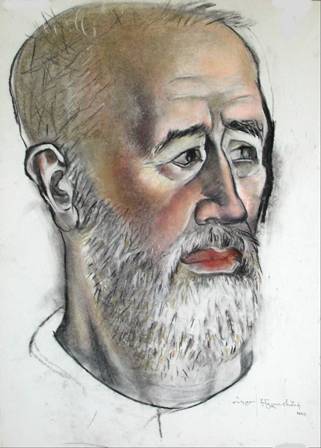
If will be fascinating to see what I write when I get
back to America about the Fulbright Impact Statement from
2001-2002, Georgia. This journal is a beginning to discuss
that impact.

Letter from
Georgia
July, 2001: The Challenge:
Waco, Texas- Any adventure
has to begin somewhere in time. This one began because Dr.
Dennis Michaelis, President of McLennan Community College,
introduced me to the work of Elzbleta Sikorska in 1999 (who
showed her work at The Art Center of Waco in April 2001),
invited Elzbleta and her Fulbright administrator husband to
Waco to tell professors about the Fulbright program abroad,
and asked Anne and I to take them out to dinner. There I
found out that someone who had a Fulbright in 1965 to Taiwan
to study Chinese art could apply again as a Fulbright
Scholar. On July 26, 2000 I applied for a museum/art
position to Georgia, grant #1442, to “teach introductory and
advanced undergraduate and graduate courses in museum
management, community outreach, and American art” at the
State Academy of Art, Tbilisi. Three good friends wrote
letters of support: Lyndon Olson, Jr., Ambassador to Sweden,
Jack Nokes, Executive Director of the Texas Association of
Museums, and Joseph Riley, attorney and man who helped to
hire me 14 years ago as Director of The Art Center of Waco.
On February 22, 2001, I received a letter which said: “On
behalf of the J. William Fulbright Foreign Scholarship
Board, it gives me great pleasure to inform you that you
have been selected for a Fulbright Scholar award in Georgia
during the 2001-02 academic year. As a Fulbrighter, you will
be joining the ranks of some 225,000 distinguished scholars
and professionals worldwide who are leaders in the
educational, political, economic, social and cultural lives
of their countries.” On the same day, I got an email from
Nato Panchulidze, Cultural Affairs Assistant, US Embassy in
Tbilisi, which outlined a beginning plan for my stay: She
wrote: “The proposed program plan for Josef Kagle: 1. A
course on exhibit planning and design with bachelor degree
students of the Tbilisi State Academy of Art and a course on
American art. 2. A course on American Art at Tbilisi State
University, Department of Art History. 3. Guest lectures at
the department of Expertise of Antiques and Art Objects at
the Georgian Technical University. 4. Guest lectures at the
Georgian Museum of Art two times per month on museum
management and Chinese art. 5. Guest lectures for high
school level students on American art history at the “Old
Gallery” and the Georgian Center for Art and Culture. 6.
Programs on American art on the first channel of State TV.
Joseph Kagle’s schedule will spread throughout the year
allowing for the maximum number of audience to benefit from
his expertise.”
Whew, it was that day that I initially felt the weight of
being the first American art scholar to be asked into the
State of Georgia since its creation as a nation in 1991. I
knew that the Communists had not allow any information on
American life or American art into the country while they
held this small nation in their Red iron fist. It was only
1992 that Georgia became the 179th member of the United
Nations. I knew all this from my questions to Washington and
Dr. Andrew Riess, who had graduated from Waco High School,
one year behind Ambassador Lyndon Olson, Jr. .
No one does anything important alone. My wife, Anne, says
that the one thing that I do well is “delegate” so I guess
that I am prepared. In fact, I have a lifetime of
preparation. Bringing accreditation to The Art Center of
Waco in 1993 and reaccreditation until 2009
in 1999 helped me review the standards set up by the
American Association of Museums (AAM). I had lectured at the
national AAM convention in 1997 on the Bernard and Audre
Rapoport International Children’s Museum of Art at Hillcrest
Professional Development School (the kids call it ICM) where
I had trained fourth and fifth graders to be director,
assistant director, curator, registrar, and members of a
Board that set policy and procedures for ICM. I figure “if
you can empower children to run a museum, you can do it for
a new nation”. I had the help of the Texas Association of
Museums, Waco Association of Museums, Texas Commission on
the Arts and my old friends and ex-colleagues at The Art
Center of Waco.
Anne and I feel that we will be travelers back in time to
country which is striving to rush into the 20th century with
its art while the rest of us are grappling with the 21st
century. I hope to bring the students and the museum
professionals into a mind set which can handle the 21st
century. For instance, all that I have seen on the Internet
of Georgian contemporary art is driven by the “object”, a
19th century mindset. With the Impressionists and the
Cubists, the 19th century object was replaced by “method
thought” or the scientific and creative method of the 20th
century. That is, from Monet and Renior the object was
broken up into color and light fragments, from Picasso and
Braque the object was made into “cones, cubes and
cylinders”. In the present world, from the Abstract
Expressionists to Robert Wilson to Lucent Technologies, the
world has become “systems thinking”. A handshake is a
“locking system” which can be compared to a door closing, a
kiss, a hug, a ship docking. a meteor crashing to earth or
Jackson Pollock dripping pigment on a canvas to create a
maze of a thicket, a cosmic galaxy or just the crosshatching
of the flow of paint.. Art jumped into the 21st century long
before the Millennium arrived. It will be my jobs in Tbilisi
to help future leaders of a new nation take the first steps
into this “systems” world.
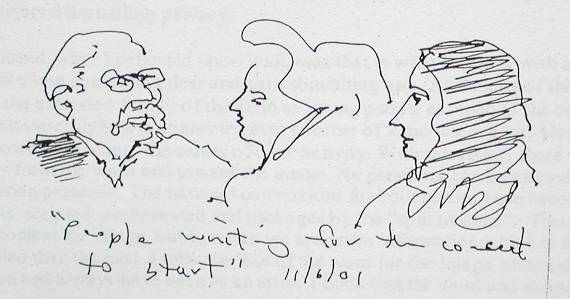
I wrote two articles,
just before learning that I was chosen as the Fulbright
Scholar to Georiga, “Reflections After Retirement” and “I am
a Mermaid.” They are important opinion articles on the
mindset before the journey to Georgia and preparing all the
educational materials which eventually would be left in
Georgia. The first step in any journey is to assess the
internal luggage that will be needed.
Reflections After Retirement
One night last week I met with a small group of people who
were special to me. They were the “doers” in our society.
Many good things that has happened to the community that I
care deeply about have happened because these individuals
worked out a dream. We were reflecting on what was needed to
raise the $9 million plus for the new downtown art museum
complex. I said, “What is needed is a 21st
century thinker with a good understanding of how people have
functioned since Ogg the Caveman used a stick to get across
a point.”
“You think that we are getting old?” one lady asked. “Have
the times passes us by?”
After a moment of reflection, I answered, “No, we have
always been beyond our times. We were the forward thinkers
in years gone by. The times have finally caught up to us.
What is needed now is not someone who can think in future
terms but someone who lives in the future without losing the
universals of the past. It is not enough to use the computer
today. One must live the computer and have a passion for
information with no sorrow about losing some degree of
privacy.”
Later, at home, in the wee hours when my mind does not let
me sleep, I thought about what I said. Probably, I had been
subconsciously thinking about my resistance to technology,
particularly cellular phones and an invasion on everyone’s
privacy. I had not watched the television show, Survivors,
but I knew about its impact. One taxi driver in Dallas had
filled me in on who won, who lost, who should have won, who
should have been kicked off the island early, etc. His wife
watched it with a passion. I just did not care. It seemed to
me that this particular television show was one more example
or assault upon a universal dwindling privacy.
What I missed, after I reflected upon it all, was what
happens with any new paradigm shift. We lose something dear
and gain something else. At the end of the 19th
century, we lost the extended family of the farm as young
people escaped to the city and the factory. When
superhighways connected every corner of America, we lost
Main Street and the downtown being the center of civic
activity. With television, there was a movement away from
the word and toward the image. No president can be elected
today without a television presence. The national
conventions for both parties have become television events,
scripted, orchestrated and packaged by the “spin masters”.
There has been a lose of content for image, but in return we
are given information which is faster and more detailed than
the past. I miss the lose of the word for the image,
although I am an image person and always have been as an
artist. I think that the word and the image can co-exist but
certainly image is what drives decisions. I was interested
in the situation in Lorena, Texas, where a high school
principle was shocked by a change in a girl’s hairstyle
(which has been accepted as one contemporary image for young
people in most of the world}. There was no written rule
against what she did. He suspended this student because she
changed her hairstyle to a 21st century image while his
background and mind were still in the 19th century. He did
forgive the boys of the football team for changing their
hair color (which was a violation of written rules). They
were not suspended. Is there a message here?
My daughter thinks nothing of flying to Dallas
from Tulsa for the day, doing several hours work, flying
back in the late afternoon, picking up her daughter,
shifting to the “mother role”, and embracing time and
distance as if they are things to be used instead of feared.
I have always been flexible. She embraces shifting
circumstances with a passion. Already, it is clear to me
those females (and men who think as care-givers) will run
most corporations and be elected president. We have outlived
the use of the general and his troops to run the nation, the
business or a high school.
Corporations are now family units and need the
well-honed skills of “motherhood” to hold that family
together. In the information age, the employee is his own
boss and all that is needed is someone with clout to cut
through the red tape of the past. What we need is BIG MOM
(even if it is a man).
Therefore on reflection, I am glad to turn over
corporate decision-making to those who totally embrace
technology as a tool to ride into the future and information
as the currency of modern life, which are not shocked by
image changes and treat employees as family. More than ever
before, today’s time is money. Decisions cannot be made on
reflection but must be made upon immediate and accurate
information about the care and feeding of the customer. I
guess that is why we have children to shape the new world.
My daughter is faster than me on the computer and thinks
that cell phones are cool. She thinks nothing of running a
division budget of over $40 million, buying computers for
American Airlines. Her daughter will be faster yet, embrace
new “cool things” and think of millions as just zeros added.
Don’t blink or the world will pass you by!
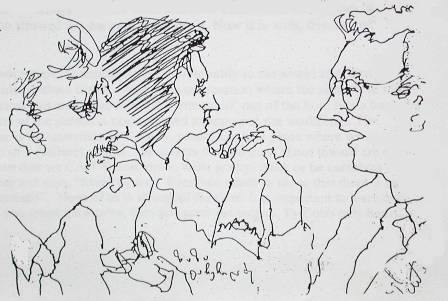
I Am A Mermaid
Sometime when you write an article, it is like throwing a
stone in a pool of water. The ripples widen and go places
that you did not imagine. I was on the exercise bike, a
captive machine, where a gentleman with a cane came up and
said, “I read your article on being enslaved by all the
stuff that we own and own us. You know what that is: the
cancer of greed. We are on the way to being an endangered
species.” I tried to tell him my point was the humor of
having things own us and once we realize it we are on the
way to using our tools instead of visa versa. He said, “You
are swimming upstream. Most people are driven by greed. Own
more not less.” It was this “upstream” comment that started
me thinking in another direction. How do many of us learn to
swim upstream? I know that I am not alone in this pursuit
but how do you learn it?
Recently I journeyed again to Everything I Really Need to
Know I Learned in Kindergarten by Waco-born Robert
Fulghum. He tells the story of running a Sunday school class
where he was setting up a game of giants, wizards and dwarfs
(a robust activity similar to the hand game of scissors,
paper and rock). All the chattering children were to find a
place in the room where they identified with one of the
three groups. Quietly, a little girl touched Fulghum’s hand
and asked, “Where do the mermaids stand?” He told her again
that the game was Giants, Wizards and Dwarfs. She replied in
a soft, firm voice, “I am a mermaid.” Being a man who goes
with the ripples of life, he said: “Stand by me. I am king
of the sea.”
The man at the gym had made me realize that “I am a
mermaid”. I do swim upstream. It all started in kindergarten
when a red-haired, six-foot, ancient (to my small eyes)
teacher brought me up to the front of the class and said,
“Look, Joe draws Goldie Locks with curls in her hair.”
Later, the same teacher sent me to Carnegie Museum where I
learned that others saw the world differently and we could
enjoy our collective difference. One day coming home on the
electric streetcar in Pittsburgh, I stopped by the downtown
fish market where my lifetime-recovering-alcoholic
grandfather worked. He took me in his strong arms, raised me
atop a counter filled with fresh fish, and announced to the
world, “Look here, my grandson is an artist.” At Dartmouth
College, it was one professor who believed that I had
something to say and write about. It was Robert Frost (poet
in residence there) who showed me the passion to say it. Now
it is wife, friends and children.
It takes someone, sometime, to announce our individuality to
the world and allow us to be who we are inside. A close
friend works for a corporation where the norm is to hide
behind the categorical suit and never allow the “mermaid”
out of the box. It is a business where the humanity of the
person is not supposed to appear at the workplace. The
invisible employee is the unwritten law. Sadly, school can
be a place where we learn that we are A, B, C, D or F
(failure) people. The targets that we must shoot toward are
drawn by others. We learn that we CAN’T read, draw, write
poetry, think or be ourselves until someone comes up and
says, “Stand by me.” Everyone needs to know that there is
some place to be a “mermaid”. None of us is strong all the
time. It is important to learn that sometimes: first you
shoot the arrows, then you paint the targets. Ty Cobb only
batted a little over 320 for his whole baseball career by
playing other people’s game. We all should have stories to
tell about someone in our lives who allowed us to be
“mermaids” and gave us the strength to stand alone by being
always there in our minds as our “stand by” person. My
friend B. Rapoport (who also is a “mermaid”) and myself had
our parents. The man at the gym is mistaken. “People are no
damn good” does not stand up to close scrutiny. The world is
not galloping toward extinction. I know because there are
too many mermaids and kings of the sea.
When friends ask, “Why do you want to go to Georgia as a
Fulbright Scholar after a successful career as a teacher and
museum professional?” I told them that all my life I was an
artist as well as a professor and museum director. Artists
are mermaids. They go against the tide sometimes. And
anyway, I want to see that part of the world and help there
if I can.”
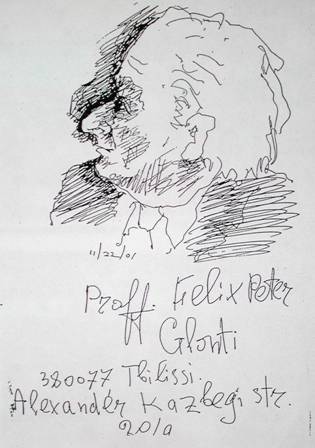

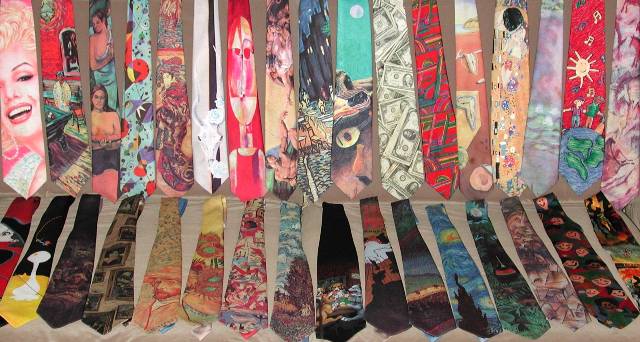
Letter from
Georgia
August, 2001: The Preparations:
Waco, Texas: Since
1993, I have been working to create a new art museum complex
in downtown Waco. I wrote to over 217 outstanding national
and international architects in 1998. A team of five of us
traveled around the country viewing the best in architecture
from the three finalists. Anyone who submitted a proposal
was sent a print that Robert Wilson, Waco-born international
artist, had donated for this cause. Some architects who sent
books of their work were sent a book in return. We thought
at the time that it was good manners: “If you are given, you
give”. There was no ulterior motive but it has paid off now.
The Fulbright grant has $1500 to buy books, slides, and
equipment for a nation that has been cut off from
information about American art for a long time. I am told
that there is nothing in Tbilisi, the capitol city of 1.5
million people, 80 different countries represented, 20
weekly and daily newspapers, 7 different radio stations and
9 TV companies and studios (governmental and independent),
in terms of American art. I know that information about
America is there. No one can shut out information anymore.
The Internet and American movies, sports and general culture
seeps in through whatever cracks are there. What is missing
is the raw materials: books, slides, videos and specifically
the actual works of art which is the heartbeat of any museum
experience. On April Fool’s Day (there must be a message
there somewhere), I wrote Tbilisi and said: “I am going to
create an American Art Collection which will be the
beginning of a source for knowledge about American Art and
Culture.” This was, you remember, on April Fool’s Day but
this was no joke.
I had jumped into Georgian life with both feet but maybe
only one eye open.
By April 14, McLennon Community College Department of Media
Services, old friends since I had taught at the college with
art appreciation for ten years while I was Director at The
Art Center of Waco, were kind enough to fit me in by
converting videos that I had used in class at MCC to
Georgian standards so that they could be used in Tbilisi. I
was really lucky because one of MCC’s transfer student was
from Russia and knew exactly what was needed to convert the
videos. I had written again to the 70 renowned American
architects of the 217 who I had dealt with in 1998 to send
books, slides and videos of their work to the American
Embassy in Tbilisi for the newly-created American Art
Collection. In late April, 168 Texas artists were asked to
send slides, books, videos, and brochures about their work.
I wanted Texas to be an important part of this American Art
Collection. You make a lot of close friends in the art
community over 14 years as Director of a Center in Waco. Art
is a flame that lights the spirit of man, I believe. Once
that flame is lit nothing is impossible through
collaboration.
For the time, I have put reproductions out of my mind since
the cost of each is out of the budget. Now is the time in
the preparation period to ask: “What is essential and
critical?”, “What would be nice to have?” and “What would be
the ideal?”
In this modern era, it is easy to find out things about
where you will be in some tomorrow at the instant in which
you live. I dial up “Georgia” on my computer and learn:
“Georgia is situated in the central and western parts of
Transcaucasus, beyond Caucaus Mountains. It is bordered by
Turkey, Russia, Armenia and Azervaijan. Its territory is
about 69,700
square kilometers (I will have to convert that to miles
sometime), and the length of its borders totals 1969 km.
Georgia’s climate zones are from continental to
subtropical.”
You learn that the Orthodox Christianity became the state
religion in 337. According to legend, “this religion was
brought in Karli (Iberia) by the Preacher Nino from
Cappadokia (now central Anatoli in Turkey)”. For the last
eight years, I have been reading and listening to
translations of the Islamic poet, al-Rumi, a 13th century
mystic poet who believe that Christians, Jews, Muslims,
Buddhist, Shaman, and all other religious people were the
same “in their heart”. A revelation, even for today, but he
was speaking in the middle of the Crusades. al-Rumi is to
the Islamic world what Shakespeare is to the West. al-Rumi
is one of my inspirations and a rare find, I thought, until
a group of us went to Seattle to visit the architectural
firm of OlsonSundberg, who The Art Center of Waco choose as
the ones to create our new downtown museum complex for the
future of the arts in Waco. We spend three days, walking
through the wonders that these architects created there;
homes, churches, and two museums: Frye (a total renovation
and face lift) and Seattle Art Museum (the upstairs
galleries). Finally, we ended the trip in a boathouse with
champagne, looking out at the marvel of Lake Washington. I
was asked to make a toast. I said, taking a line from Rumi,
“May the beauty we love be what we do.” Without a break,
Alan Maskin, one of the OlsonSundberg architects, continued,
“There are hundreds of ways to kneel and kiss the ground.”
With my mouth open, since I thought that I had discovered
Rumi, I finally smiled. Now, when preparing for Georgia, I
find that Preacher Nino was from Cappadokia, the birthplace
of al-Rumi. I wrote to Dr. Riess of the CIES in Washington
and he emailed back, “Indeed, St. Nano (spelling is
interesting between Georgia and here) was a Cappadocian lady
and, after curing Queen Nana (this can get confusing)
Georgia joined the ranks of Christianized states. Of course,
they have to get in line behind St. Gregory the Illuminator
and the Armenians. But you are on the money with al-Rumi.
One of my graduate minors was the Ottoman Empire, so I
became fairly familiar with him, his writings, and the Sufi
traditions of Turkey and Central Asia. Fascinating.
Especially since he speaks so clearly to many “modern”
souls.” And I thought that I had discovered al-Rumi. Another
Wacoan had been there long before my awakening.
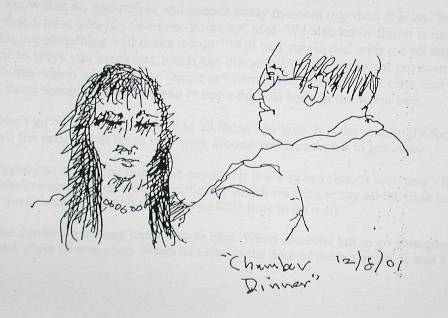
Special note: It is important to realize that the
following letter was written before I left America. My
editor wanted all articles for the magazine in his hands at
least two months before publication, therefore Letter from
Georgia 3 is the only one that was not written on the spot,
in the country, when I say I am here, and it shows it. I
left it in this collection because it is a good example of
what can be gotten from the internet in today’s world. It is
also a good example of the job done by public relations
individuals and tour agents. I place it before the real
experience as a contrast.
Letter from Georgia
September, 2001: The First Days: Tbilisi, Georgia:
Legend seems to be the stuff of Georgia. The legend of
Tbilisi states that while hunting in the impenetrable
forests that once covered the slopes of the Kura valley,
Vakhtang Gorgasali, King of Karthi (446-502), hit a pheasant
with his arrow. But when he galloped up to retrieve the
bird, he saw that it had fallen into a warm string and its
wound had healed. Amazed by the discovery, he announced that
he would found a city there to be called “Tbilisi” )(“thili”
in Georgian means “warm”) and move his capital from
Miskheta. Therefore Anne and I are journeying to the land of
myth, legend, mysteries and the warm healing waters called
Tbilisi. Here, at the crossroads of East and West, Jason
sought the Golden Fleece and discovered instead the
enchanting Media. Maybe that is where the Georgians learned
to sue herbs in their food.
We dined the first night at a restaurant called Sachashnika,
where we found Georgian specialties in a vaulted brick space
that was once a wine cellar. In fact, we drank our wine
labeled from amphoras buried in the floor. We learned about
this place from Gournet Magazine, September 2000 Special
Issue. You can gain much knowledge about Georgia from the
Internet. If you are looking on visiting Tbilisi, the quaint
hotel Mtsis Brali is “a bit run-down but still charming and
a bargain at only $50 a night”. Of course, many American
tourists and business travelers stay at Betsy’s, a Tbilisi
institution.
From the CIA, one reads: “Medical care in Georgian is
limited. There is a severe shortage of basic medical
supplies, including disposable needles, anesthetics, and
antibiotics. Elderly travelers and those with pre-existing
health problems may be at risk due to inadequate
facilities.” Anne and I now include ourselves with the
elderly. Being old in this culture seems just right,
although the young are all around creating a new nation.
From the US Embassy newsletter, one reads: “The US Embassy
advises American citizens to avoid travel to the
separatist-controlled region of Abkhazia (in the upper most
corner of Georgia, near the Russian border). There are
reports of continued fighting and terrorist activity in
Abkhazia (and around Zugdid), including attacks and
kidnapping of international observers. These incidents have
included bombings and the mining of roads which pose a
serious threat to vehicular traffic.” We decided long before
we got here to not to travel north from Tbilisi. In every
city there are places that you do not go at night, so not
going north is no loss.. We may visit Turkey and the
birthplace of al-Rumi and Istanbul to finally see the
wonders of Hagia Sophia (which I have been teaching about in
slide form since 1958). It would be nice to go north. I did
my graduate work in art at the University of Colorado. If
the Rockies are the mother of mountains, the Caucasus is the
father. “Bombing and kidnapping”? No, that region of the
Caucasus can wait.
Why were we so excited about our journey to Tbilisi,
Georgia. Part of the answer is the adventure of travel. In
the Old Town we wander the winding streets and admire the
ornate wooden houses. You can’t visit Tbilisi without taking
a hot sulphur bath. On the third floor of the Georgian State
Art Museum (where I will start a series of lectures in a few
days on American and Chinese art) are the paintings of
Pirosmani (well worth the modest admission price). Part of
the answer is the challenge of being the first art museum
professional/artist/teacher to be asked to come into this
country and help improve their cultural condition. Part of
the answer is the people that I have met in these first
days. Mostly, the answer lies in what I initially wrote to
the Fulbright Committee: “My children are grown and have
their own lives now. We have never been to this part of the
world, although our travels are extensive.”
On a personal basis, it is spiritually fulfilling to visit
here. East meets West. Old wakes to the New. The Byzantine
murals, the work of Damiane, Jemal Khutsiahvili and Archil
Vephhvadze interest me as a curator and as an artist.
Mostly, this is the right time in my life. I have years of
experience that I can share. I am free to choose my own path
and my own interests, while still sharing that path with
others. I will create an exchange exhibition of children’s
art here and share it with creative minds of Waco’s
children. A friend once told me that he traveled because he
met himself coming around the other way. It is true. You
examine your life in a new light, with new eyes. Lastly, my
own painting will grow by stepping back into history. I hope
to mix the rich tradition of religious Icon-making with the
images of today in my own work. An adventure which started
long ago continues in this new place, Tbilisi, Georgia.
After thought: What is of interest to me in this magazine
article is that I said many things which are still true
about motivation and reasons for coming to Georgia. What is
almost comical now is the naiveté of this writer about the
place, the people and the experience. At that time, I was a
romantic looking from afar; now, I am a realist who sees
with open eyes.
Before leaving for Georgia, many of our friends said,
“Don’t go, it is dangerous over there.” Therefore I wrote
the following article on that phrase as a way to empathize
with their sentiments and at the same time release Anne and
I from our life there since we were going together to a new
place, a new adventure.
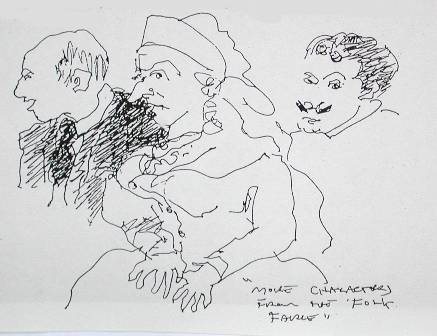
Don’t Go
Waking in the dark room, lying in the warmth of the covers,
feeling the vacancy beside me, the words come clear and
sure, “Don’t go.” There are the genre sounds of movement in
the house: the getting ready for work sounds. My wife has to
go shopping for bread and cheese. She used to cure all ills
of the world. For me now, sleep not an option.
Like rolling something bittersweet around in the
cavity of your mouth, the words roll in my mind, “Don’t go.”
“Don’t” is so abrupt with the “t” at the end, and “go” is
positively terminal. It is not like “Don’t leave” which
strings you out smoothly to the idea. The “g” is guttural,
like a sound some caveman might utter. The “o” is a period
at the end of a sentence or lament. Inwardly, it is a
thought and then verbally, on a whim, spoken aloud, “Don’t
go.”
Those are the words a child might say to a
mother. It is what my cat says by brushing against my leg or
sitting on my papers. It is “Here we are. Why must we be
parted?” It is what I saw recently on the face of friend
whose wife is dying of cancer. It is a lover’s statement in
the night.
Most of the time, “Don’t go” is impossible to
control. Knowing that it is impossible just makes it that
much more appealing. The reply is a foregone conclusion, “I
must go. Friday I am off work. We could make a time to meet
then. Can you get off? Someday we will both retire and have
the time to stay.”
We know that no one retires and spends every
moment together. It is an “how-
do-I-know-that-I-miss-you-if-you-never-go-away” idea. We
also know that it is naive to think that saying something
will make it true. “Will you stay in bed with me all day,
allowing me to serve you breakfast, lunch and dinner? Will
you really not go, even to do the daily chores which have
become “must do” items? For just this short time, can work
wait?” All these thoughts come rushing in upon the still
body in the warm bed.
“Don’t go” is a call in the night to all those
you love. It is the seemingly-foolish outcry to all the
people that when they were around you found time to get
away.
Maybe just to say and think it is enough. It is
a way to voice, “I love you”. It is a way to verbalize some
inner need of continuity which we wish to say all the time
but forget because there is so much to do and so little time
to do it all.
The American Indians had a unique idea. When
someone left to go someplace, no time passed while he was
gone. When he came in the door of the hut again, it was a
continuation of the time when he was with us. For their
culture, “don’t go” may not have been needed. The individual
self was in all the things around- the sky, the night, the
bear, the eagle, the wide plain, a grandchild, the wind, or
a gentle rain..
“Don’t go” is our call on the wind. We know that
it is not possible except on honeymoons or while courting or
as a castaway on a boat at sea or on some desert oasis or in
the early morning when my wife is getting ready for work. It
is a call to all those who we wish could be eternally here.
Just maybe it is the first cry of a baby for his mother or
father. The sadness comes in its futility. The wonder comes
in its possibility. So for you all out there in the night,
“Don’t go.”
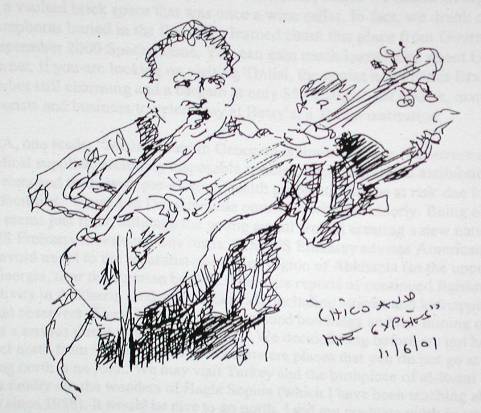
 |

